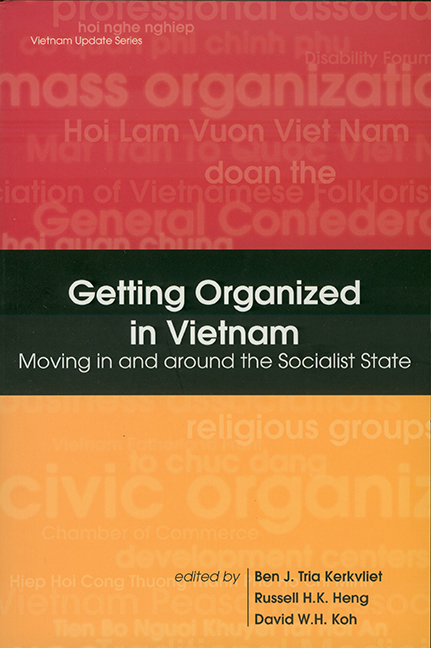Book contents
- Frontmatter
- Contents
- Preface
- Abbreviations
- Introduction: Grappling with Organizations and the State in Contemporary Vietnam
- 1 From Fence-Breaking to Networking: Interests, Popular Organizations, and Policy Influences in Post-Socialist Vietnam
- 2 Business Associations and Policy-Making in Vietnam
- 3 NGOs and Highland Development: A Case Study in Crafting New Roles
- 4 The Disabled and Their Organizations: The Emergence of New Paradigms
- 5 Authoritarian Governance and Labour: The VGCL and the Party-State in Economic Renovation
- 6 The Relationship between Civic and Governmental Organizations in Vietnam: Selected Findings
- 7 Donors, Local Development Groups and Institutional Reform over Vietnam's Development Decade
- Index
- About the Contributors
1 - From Fence-Breaking to Networking: Interests, Popular Organizations, and Policy Influences in Post-Socialist Vietnam
Published online by Cambridge University Press: 21 October 2015
- Frontmatter
- Contents
- Preface
- Abbreviations
- Introduction: Grappling with Organizations and the State in Contemporary Vietnam
- 1 From Fence-Breaking to Networking: Interests, Popular Organizations, and Policy Influences in Post-Socialist Vietnam
- 2 Business Associations and Policy-Making in Vietnam
- 3 NGOs and Highland Development: A Case Study in Crafting New Roles
- 4 The Disabled and Their Organizations: The Emergence of New Paradigms
- 5 Authoritarian Governance and Labour: The VGCL and the Party-State in Economic Renovation
- 6 The Relationship between Civic and Governmental Organizations in Vietnam: Selected Findings
- 7 Donors, Local Development Groups and Institutional Reform over Vietnam's Development Decade
- Index
- About the Contributors
Summary
Political and economic reforms beginning in the 1980s have, as correctly observed by Carlyle Thayer, led to “a loosening of the party's mono-organizational grip on society and to the explosion of private activities, which the state has found difficult to control” (Thayer 1992, p.110). In post-socialist Vietnam, this loosening provided opportunities for citizens to form groupings in pursuit of certain common interests. By the end of the 1990s, the Vietnamese themselves began to use the term “non-governmental organization” (co quan phi chinh phu) to refer to popular organizations that were loosely connected to the party-state structure, financially self-sufficient and involved in development work once considered as falling under the jurisdiction of the party-state.
This paper focuses on how popular organizations, both state and non-state sponsored, influenced the policy-making process in the era of doi moi. It examines the relationship between interests, organizational networking, and policy influence. It argues that although popular organizations—state and non-state sponsored—continued to be closely associated with the party-state structure, they assumed an increasingly important role as advocates and pioneers for policy options on behalf of certain interests. Operating under the structure of the one-party state, the successful organizations were the ones that could muster political resources by both vertical networking with certain sections of the party-state hierarchy, and horizontal networking with other popular organizations. The vertical alliance provided the necessary policy support from elements within the party-state, while the horizontal alliance helped to legitimize the policy position these organizations are adopting. I argue that this model of policy influence departs from that developed under state socialism in which interest aggregation was top-down, the mobilization channels for policy influence were vertically and sectorally- based, and policy positions were expressed mostly through the method of “fence-breaking” (pha rao), i.e., violations of rules and regulations set up by the party-state. This influence in policy-making marks a transformation of the mono-organizational structure, from so-called “exclusionary” towards some degree of “inclusionary” corporatism.
- Type
- Chapter
- Information
- Getting Organized in VietnamMoving in and around the Socialist State, pp. 25 - 61Publisher: ISEAS–Yusof Ishak InstitutePrint publication year: 2003



